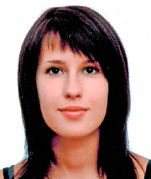Content

Abstract:
Many researchers considered improvement of colour discrimination an important factor of surgery illumination, but none of them provided data on colour contrast estimation. The article describes the results of an extensive search of spectrum that are the most preferable for application in surgery equipment using selected light emitting diodes (LED) of different types. The search was not also based on the qualitative characteristics recommended by the standard, but also on a previously non-considered parameter: colour contrast between human tissues K estimated in uniform-chromaticity systems. The programme developed in MATLAB environment allows to model the cumulative spectrum of a LED light source, to determine the proportions of LED radiation or crystals in LED providing the maximum value of LED general colour rendering index Ra at the set correlated colour temperature or the maximum value of averaged K in uniform-chromaticity systems both in presence of the limited Ra value of 85 and if there are no limitations. Such options of spectrum search allowed to evaluate the probability of K change and its maximum, as well as to identify three possible operating modes of surgery equipment when using the said LEDs. The first of them is following the existing recommendations for Ra with possible insignificant change of K, the second one is the priority of K assuming violation of the Ra recommendations to increase K, and the third option assumes switching between the modes if necessary. LED spectra are selected for such different modes. Other colour rendering indexes are also estimated, and the authors recommend using the new standard TM‑30–15 for standardisation of the colour rendering quality of light sources used in surgery luminaires. It is based on 99 samples and some of the tests have reflective properties close to those of human tissues.
References:
1. Murai, K., Kawahira, H., Haneishi, H. Improving colour appearance of organ in surgery by optimally designed LED illuminant / IFMBE Proc. Berlin: Springer, 2013, Vol. 39, pp. 1010–1013. 2. Shen, J., Wang, H, Wu, Y., Li, A., Chen, C., Zheng, Z. Surgical lighting with contrast enhancement based on spectral reflectance comparison and entropy analysis / State Key Laboratory of Modern Optical Instrumentation, Zhejiang University, China, 2017. 3. Wilson, R.H., Nadeau, K.P., Jaworski, F.B., Tromberg, B.J., Durkin, A.D. Review of short-wave infrared spectroscopy and imaging methods for biological tissue characterization, 2017. 4. Pratavieira, S., Navascues, F.F., de Souza, L.M. et al. Tissue slides analysis using Red, Green and Blue LEDs as microscope light source / Carlos Institute of Physics, University of São Paulo, PO Box 369, 13560–970, São Carlos, SP, Brazil, 2018. 5. Kurabuchi, Y., Nakano, K., Ohnishi, T. et al. Optimization of surgical illuminant spectrum for organ microstructure visualization // IEEE Access, 2019, # May, pp. 70733–70741. 6. Aladov, A.V., Sackheim, A.L., Semyashkina, Yu.V., Chernyakov, A.E. Dynamically Controlled LED Luminaire for Contrast Visualisation of Biological Tissues During Surgical Procedures [Dinamicheski upravlyaemyi svetilnik so svetodiodami dlya kontrastnoy vizualizatsii biologicheskikh tkaney pri khirurgicheskikh operatsiyakh] // Svetotekhnika, 2021, # 5, pp. 53–57. 7. GOST R IEC60601–2–41–2014 Medical electrical equipment. Part 2–41. Particular requirements for the basic safety and essential performance of surgical luminaires and luminaires for diagnosis. 8. Aladov, A.V., Biryuchinsky, S.B., Dubinina, M.V., Zakgeym, A.L., Mizerov, M.N. Colour-dynamics Controlled Surgical Luminaire with a Full-colour Light Emitting Diode [Tsvetodinamicheski upravlyaemyi oeratsionnyi svetilnik s polnotsvetnym svetodiodom] // Svetotekhnika, 2012, # 2, pp. 13–18. 9. Evaluating Colour Rendition Using IES TM‑30–15, 2015. URL: https://www.energy.gov/sites/prod/files/2016/04/f30/tm‑30_fact-sheet.pdf (date of reference: 25.03.2022). 10. Fairchild, M.D. Colour Appearance Models [Modeli tsvetovogo vospriyatiya] / 2nd edition, 2004 / Trans. by A. Shadrin, 2006, 439 p. 11. Meshkov, V.V., Matveev, A.B. Basics of Light Engineering: Study Guide for Higher Education Institutions: in 2 parts. Part 2. Physiological Optics and Colorimetry [Osnovy svetotekhniki: uchebnoye posobiye dlya vuzov: v 2 ch. Ch. 2. Fiziologicheskaya optika i kolorimetriya]. 2nd edition, revised and supplemented / Moscow: Energoatomizdat, 1989, 431 p. 12. Sosnova, T.L., Frid, Yu.V., Sokolova, E.G., Loseva, E.I. Colour Schemes of Railway Transport [Tsvetovoye oformleniye na zheleznodorozhnom transporte] / Moscow: Transport, 1984, 200 p. 13. Kudryakova, S.M., Snetkov, V.Yu. The Study of Visual Performance and Fatigue during works with Black Text against Coloured Background [Issledovniye zritelnoy rabotosposobnosti i utomleniya pri rabote s chyornym textom na tsvetnom fone] // Svetotekhnika, 2016, # 2, pp. 48–51. 14. Novoselskaya, O.A. The Theory of Colour and Colour Rendering. A Study Guide [Teoriya tsveta i tsvetovosproizvedeniya] / Minsk: BSU Press, 2013, 196 p.
Keywords
- general colour rendering index
- colour contrast
- biological tissues
- light emitting diodes
- LED luminaires
Recommended articles
Testing and Analysis of Characteristics of Low-Pressure Mercury and Amalgam Bactericidal UV Lamps by Various Manufacturers. L&E 27 (6) 2019
Higher Education with a Specialisation in Light Engineering and Light Sources and Transfer to FSES 3++. L&E 27 (5) 2019



